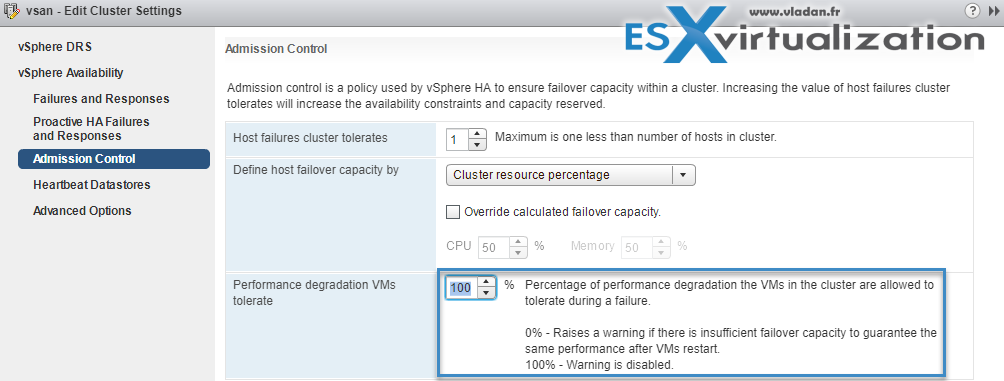vSphere HA slot sizes are used to calculate the number of VMs that can be powered on in an HA cluster with 'Host failures cluster tolerates' selected. The slots size is calculated based on the size of reservations on the VMs in the cluster. HA Admission Control then prevents new VMs being powered on if it would not leave any slots available should a host fail.
The HA Deep Dive has been updated as part of the vSphere Clustering Deep Dive. The book (paper) can be bought through Amazon, or get the ebook version for free through Rubrik. The VMware vSphere 6.7 Clustering Deep Dive is the long-awaited follow-up to best seller vSphere 5.1 Clustering Deep Dive and zooms in on the critical components of.
The slot size for a cluster can be seen by going to the Summary Page for the cluster and clicking the 'Advanced Runtime Info' link in the HA box.
- Sep 13, 2015 Slot is a logical representation of CPU and memory. Depending on vSphere version, the default slot size is 0 MB of RAM and 256 MHz CPU (4.1 and earlier) or 0 MB of RAM and 32Mhz (5.0 and later). The admission control is performed by VMware HA with the following steps.
- When implementing the Cisco Nexus 1000v, High Availability (HA) Slot Sizes can be affected on your vSphere Cluster. HA slot sizes are used to calculate failover capacity for HA when the 'Host Failures' HA setting is used. By default the slot size for CPU is the highest reservation of CPU among all VM's in the cluster (or 256 MHz if no per.
- Slot size is calculated using the largest reservations plus the memory overhead of any powered on virtual machines in the cluster. However, vSphere HA admission control considers only the resources on a host that are available for virtual machines.
- (For more information about slot size calculation, please review the HA deep dive page on yellow-bricks.com.) There are options to avoid creation of large slot sizes. Such as not setting reservations, disabling strict admission control, using vSphere new admission control policy 'percentage of cluster resources reserved' or creating a.
If none of the VMs have CPU or RAM reservations, a default of 256MHz and 0GB is used.

The slots per host is derived by taking the total available CPU/RAM for the host and dividing by the slot size. Some CPU is reserved for the system so it will usually be a little lower than the full amount. So a host with 2xquad-core 2.4GHz CPUs (total 19.2GHz) and no VM CPU or RAM reservations has 73 slots and will only allow 73 VMs to be powered on if the cluster has two hosts and is set to protect against a single host failure.
Obviously this allows a very minimal amount of resource for each VM, so either reservations should be set for each VM, or slots size can be manually adjusted (see the VMware vSphere Availability Guide (pdf) for full details).
Note that the slot size is used for admission control calculations only. It has no direct effect on the resources available to VMs should an HA event occur.
There is a VMware Knowledgebase article (1010594) which has some details of the difference in VI3 and vSphere 4.x.
This has always been a hot topic, HA and Slot sizes/Admission Control. One of the most extensive (Non-VMware) articles is by Chad Sakac aka Virtual Geek, but of course since then a couple of things has changed. Chad commented on my HA Deepdive if I could address this topic, here you go Chad.
Slot sizes
Lets start with the basics.

What is a slot?
A slot is a logical representation of the memory and CPU resources that satisfy the requirements for any powered-on virtual machine in the cluster.
In other words a slot size is the worst case CPU and Memory reservation scenario in a cluster. This directly leads to the first 'gotcha':
HA uses the highest CPU reservation of any given VM and the highest memory reservation of any given VM.
If VM1 has 2GHZ and 1024GB reserved and VM2 has 1GHZ and 2048GB reserved the slot size for memory will be 2048MB+memory overhead and the slot size for CPU will be 2GHZ.
Vsphere Ha Slot Size Calculation
Now how does HA calculate how many slots are available per host?
Of course we need to know what the slot size for memory and CPU is first. Then we divide the total available CPU resources of a host by the CPU slot size and the total available Memory Resources of a host by the memory slot size. This leaves us with a slot size for both memory and CPU. The most restrictive number is the amount of slots for this host. If you have 25 CPU slots but only 5 memory slots the amount of available slots for this host will be 5.
As you can see this can lead to very conservative consolidation ratios. With vSphere this is something that's configurable. If you have just one VM with a really high reservation you can set the following advanced settings to lower the slot size being used during these calculations: das.slotCpuInMHz or das.slotMemInMB. To avoid not being able to power on the VM with high reservations these VM will take up multiple slots. Keep in mind that when you are low on resources this could mean that you are not able to power-on this high reservation VM as resources are fragmented throughout the cluster instead of located on a single host.

The slots per host is derived by taking the total available CPU/RAM for the host and dividing by the slot size. Some CPU is reserved for the system so it will usually be a little lower than the full amount. So a host with 2xquad-core 2.4GHz CPUs (total 19.2GHz) and no VM CPU or RAM reservations has 73 slots and will only allow 73 VMs to be powered on if the cluster has two hosts and is set to protect against a single host failure.
Obviously this allows a very minimal amount of resource for each VM, so either reservations should be set for each VM, or slots size can be manually adjusted (see the VMware vSphere Availability Guide (pdf) for full details).
Note that the slot size is used for admission control calculations only. It has no direct effect on the resources available to VMs should an HA event occur.
There is a VMware Knowledgebase article (1010594) which has some details of the difference in VI3 and vSphere 4.x.
This has always been a hot topic, HA and Slot sizes/Admission Control. One of the most extensive (Non-VMware) articles is by Chad Sakac aka Virtual Geek, but of course since then a couple of things has changed. Chad commented on my HA Deepdive if I could address this topic, here you go Chad.
Slot sizes
Lets start with the basics.
What is a slot?
A slot is a logical representation of the memory and CPU resources that satisfy the requirements for any powered-on virtual machine in the cluster.
In other words a slot size is the worst case CPU and Memory reservation scenario in a cluster. This directly leads to the first 'gotcha':
HA uses the highest CPU reservation of any given VM and the highest memory reservation of any given VM.
If VM1 has 2GHZ and 1024GB reserved and VM2 has 1GHZ and 2048GB reserved the slot size for memory will be 2048MB+memory overhead and the slot size for CPU will be 2GHZ.
Vsphere Ha Slot Size Calculation
Now how does HA calculate how many slots are available per host?
Of course we need to know what the slot size for memory and CPU is first. Then we divide the total available CPU resources of a host by the CPU slot size and the total available Memory Resources of a host by the memory slot size. This leaves us with a slot size for both memory and CPU. The most restrictive number is the amount of slots for this host. If you have 25 CPU slots but only 5 memory slots the amount of available slots for this host will be 5.
As you can see this can lead to very conservative consolidation ratios. With vSphere this is something that's configurable. If you have just one VM with a really high reservation you can set the following advanced settings to lower the slot size being used during these calculations: das.slotCpuInMHz or das.slotMemInMB. To avoid not being able to power on the VM with high reservations these VM will take up multiple slots. Keep in mind that when you are low on resources this could mean that you are not able to power-on this high reservation VM as resources are fragmented throughout the cluster instead of located on a single host.
Host Failures?
Now what happens if you set the number of allowed host failures to 1?
The host with the most slots will be taken out of the equation. If you have 8 hosts with 90 slots in total but 7 hosts each have 10 slots and one host 20 this single host will not be taken into account. Worst case scenario! In other words the 7 hosts should be able to provide enough resources for the cluster when a failure of the '20 slot' host occurs.
And of course if you set it to 2 the next host that will be taken out of the equation is the host with the second most slots and so on.
What more?
Vsphere Ha Slot Size Chart
One thing worth mentioning, as Chad stated with vCenter 2.5 the number of vCPUs for any given VM was also taken in to account. This led to a very conservative and restrictive admission control. This behavior has been modified with vCenter 2.5 U2, the amount of vCPUs is not taken into account.

